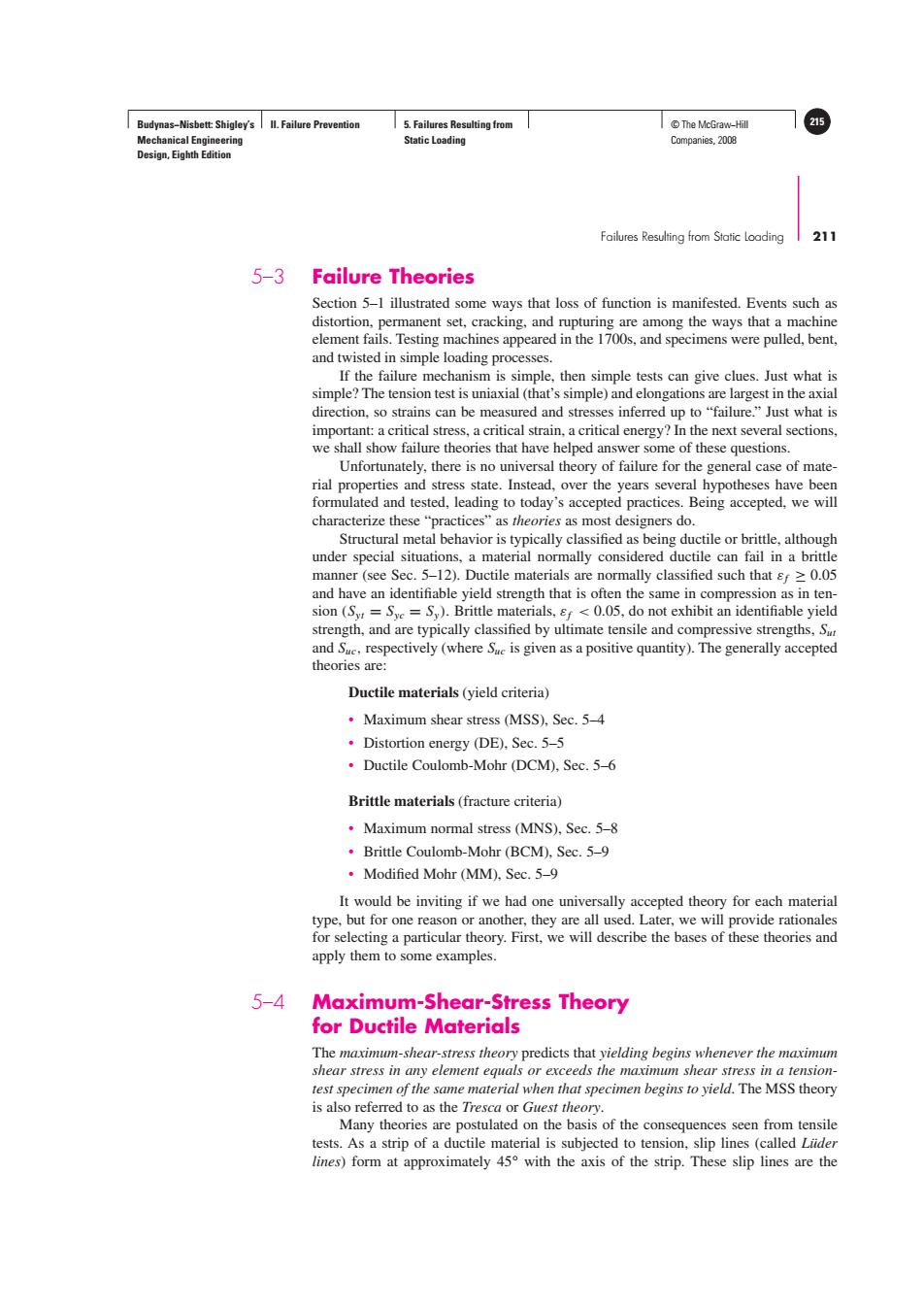正在加载图片...

Budynas-Nisbett:Shigley's ll.Failure Prevention 5.Failures Resulting from T©The McGraw-Hill 215 Mechanical Engineering Static Loading Companies,2008 Design,Eighth Edition Failures Resulting from Static Loading 211 5-3 Failure Theories Section 5-1 illustrated some ways that loss of function is manifested.Events such as distortion,permanent set,cracking,and rupturing are among the ways that a machine element fails.Testing machines appeared in the 1700s,and specimens were pulled,bent, and twisted in simple loading processes. If the failure mechanism is simple,then simple tests can give clues.Just what is simple?The tension test is uniaxial (that's simple)and elongations are largest in the axial direction,so strains can be measured and stresses inferred up to"failure."Just what is important:a critical stress,a critical strain,a critical energy?In the next several sections, we shall show failure theories that have helped answer some of these questions. Unfortunately,there is no universal theory of failure for the general case of mate- rial properties and stress state.Instead,over the years several hypotheses have been formulated and tested,leading to today's accepted practices.Being accepted,we will characterize these "practices"as theories as most designers do. Structural metal behavior is typically classified as being ductile or brittle,although under special situations,a material normally considered ductile can fail in a brittle manner(see Sec.5-12).Ductile materials are normally classified such that 0.05 and have an identifiable yield strength that is often the same in compression as in ten- sion (Syr=Syc=Sy).Brittle materials,<0.05,do not exhibit an identifiable yield strength,and are typically classified by ultimate tensile and compressive strengths,Sr and Suc,respectively (where Se is given as a positive quantity).The generally accepted theories are: Ductile materials(yield criteria) Maximum shear stress (MSS),Sec.5-4 Distortion energy (DE),Sec.5-5 Ductile Coulomb-Mohr (DCM).Sec.5-6 Brittle materials (fracture criteria) Maximum normal stress (MNS).Sec.5-8 Brittle Coulomb-Mohr (BCM).Sec.5-9 Modified Mohr(MM).Sec.5-9 It would be inviting if we had one universally accepted theory for each material type,but for one reason or another,they are all used.Later,we will provide rationales for selecting a particular theory.First,we will describe the bases of these theories and apply them to some examples. 5-4 Maximum-Shear-Stress Theory for Ductile Materials The maximum-shear-stress theory predicts that yielding begins whenever the maximum shear stress in any element equals or exceeds the maximum shear stress in a tension- test specimen of the same material when that specimen begins to yield.The MSS theory is also referred to as the Tresca or Guest theory Many theories are postulated on the basis of the consequences seen from tensile tests.As a strip of a ductile material is subjected to tension,slip lines (called Liider lines)form at approximately 45 with the axis of the strip.These slip lines are theBudynas−Nisbett: Shigley’s Mechanical Engineering Design, Eighth Edition II. Failure Prevention 5. Failures Resulting from Static Loading © The McGraw−Hill 215 Companies, 2008 Failures Resulting from Static Loading 211 5–3 Failure Theories Section 5–1 illustrated some ways that loss of function is manifested. Events such as distortion, permanent set, cracking, and rupturing are among the ways that a machine element fails. Testing machines appeared in the 1700s, and specimens were pulled, bent, and twisted in simple loading processes. If the failure mechanism is simple, then simple tests can give clues. Just what is simple? The tension test is uniaxial (that’s simple) and elongations are largest in the axial direction, so strains can be measured and stresses inferred up to “failure.” Just what is important: a critical stress, a critical strain, a critical energy? In the next several sections, we shall show failure theories that have helped answer some of these questions. Unfortunately, there is no universal theory of failure for the general case of material properties and stress state. Instead, over the years several hypotheses have been formulated and tested, leading to today’s accepted practices. Being accepted, we will characterize these “practices” as theories as most designers do. Structural metal behavior is typically classified as being ductile or brittle, although under special situations, a material normally considered ductile can fail in a brittle manner (see Sec. 5–12). Ductile materials are normally classified such that εf ≥ 0.05 and have an identifiable yield strength that is often the same in compression as in tension (Syt = Syc = Sy ). Brittle materials, εf < 0.05, do not exhibit an identifiable yield strength, and are typically classified by ultimate tensile and compressive strengths, Sut and Suc, respectively (where Suc is given as a positive quantity). The generally accepted theories are: Ductile materials (yield criteria) • Maximum shear stress (MSS), Sec. 5–4 • Distortion energy (DE), Sec. 5–5 • Ductile Coulomb-Mohr (DCM), Sec. 5–6 Brittle materials (fracture criteria) • Maximum normal stress (MNS), Sec. 5–8 • Brittle Coulomb-Mohr (BCM), Sec. 5–9 • Modified Mohr (MM), Sec. 5–9 It would be inviting if we had one universally accepted theory for each material type, but for one reason or another, they are all used. Later, we will provide rationales for selecting a particular theory. First, we will describe the bases of these theories and apply them to some examples. 5–4 Maximum-Shear-Stress Theory for Ductile Materials The maximum-shear-stress theory predicts that yielding begins whenever the maximum shear stress in any element equals or exceeds the maximum shear stress in a tensiontest specimen of the same material when that specimen begins to yield. The MSS theory is also referred to as the Tresca or Guest theory. Many theories are postulated on the basis of the consequences seen from tensile tests. As a strip of a ductile material is subjected to tension, slip lines (called Lüder lines) form at approximately 45° with the axis of the strip. These slip lines are the